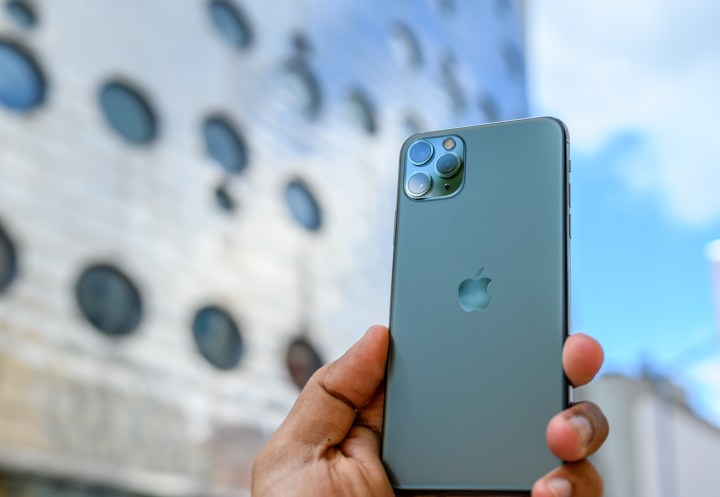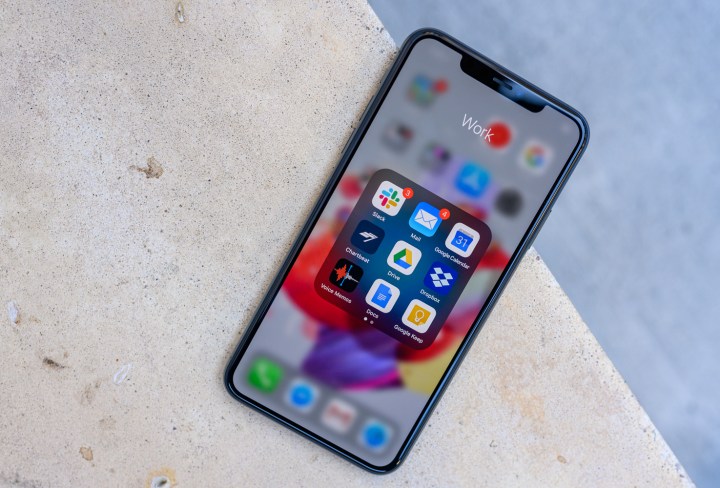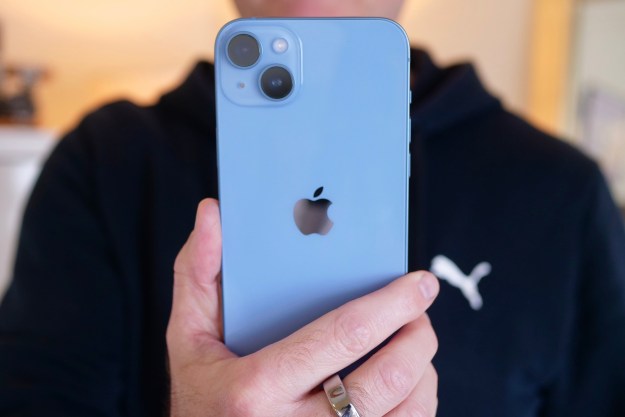The OnePlus 8 Pro has been revealed, and it’s everything we love about OnePlus phones. It packs the latest, high-powered hardware, an updated and sleek design, 5G connectivity, and a truly innovative camera that includes features we’ve never seen before in a smartphone camera.
But those upgrades come at a price, and it seems the OnePlus 8 Pro has become the very thing it swore to destroy — a highly priced flagship phone. With the OnePlus 8 Pro’s top model now sitting at $1,000, it’s in direct competition with the likes of Apple’s biggest and baddest flagship phone, the iPhone 11 Pro Max. With a higher price, does the OnePlus 8 Pro have what it takes to hunt down Apple’s finest? We took a look to find out.
Specs
| OnePlus 8 Pro | iPhone 11 Pro Max | |
| Size | 165.3 x 74.4 x 8.8 mm (6.51 x 2.93 x 0.35 inches) | 158 x 77.8 x 8.1 mm (6.22 x 3.06 x 0.32 inches) |
| Weight | 193 grams (6.81 ounces) | 226 grams (7.97 ounces) |
| Screen size | 6.78-inch Fluid AMOLED | 6.5-inch Super Retina XDR OLED |
| Screen resolution | 3,168 x 1,440 pixels (513 pixels-per-inch) | 2688 x 1242 pixels (458 pixels-per-inch) |
| Operating system | Android 10 (under OxygenOS) | iOS 13 |
| Storage | 128GB, 256GB | 64GB, 256GB, 512GB |
| MicroSD card slot | No | No |
| Tap-to-pay services | Google Pay | Apple Pay |
| Processor | Qualcomm Snapdragon 865 | Apple A13 Bionic chip |
| RAM | 8GB, 12GB | 4GB |
| Camera | 48-megapixel, 48MP wide-angle, 8MP telephoto rear, and Color Filter rear, 16MP front | Triple lens 12MP wide, 12MP ultrawide, and 12MP telephoto rear; 12MP TrueDepth front |
| Video | 4K at 60 frames per second, 1080p at 240 fps, 720p at 960 fps | 4K at up to 60 fps, 1080p at 240 fps |
| Bluetooth version | 5.0 | 5.0 |
| Ports | USB-C | Lightning |
| Fingerprint sensor | Yes, in-display | No, Face ID instead |
| Water resistance | IP68 | IP68 |
| Battery | 4,510mAh
Warp Charge fast charging (30W) Fast Qi wireless charging (30W) |
3,969mAh
Fast charging (18W) Qi wireless charging |
| App marketplace | Google Play Store | Apple App Store |
| Network support | Verizon, T-Mobile | AT&T, T-Mobile, Sprint, Verizon |
| Colors | Glacial Green, Ultramarine Blue, Onyx Black | Midnight Green, Space Gray, Silver, Gold |
| Prices | $900 | $1,100 |
| Buy from | OnePlus | Apple, Best Buy |
| Review score | 4 out of 5 stars | 4.5 stars out of 5 |
Design, display, and durability
- 2. iPhone 11 Pro Max
You may think the OnePlus 8 Pro looks quite similar to past OnePlus phones — and you’d be right. But there are significant differences past the first glance. The first is the removal of the mechanical pop-up selfie camera, which has been replaced with a punch-hole camera in the display. It’s still made from glass, but it’s been treated with a matte coating, which reduces fingerprints significantly. There’s barely any bezel around the front, and the 6.78-inch Fluid AMOLED display is absolutely stunning — but the 120Hz refresh rate is undoubtedly the star of the show here, even if the motion smoothing is a little dodgy.
The iPhone 11 Pro Max has a similar level of polish, as it, too, is a big phone with barely any bezel and a large screen. But unlike the OnePlus’ punch-hole, the iPhone still rocks a large notch in the display, which some will see as ugly. Despite being smaller, the iPhone is definitely the heavier of the two phones, and that’s largely down to the stainless steel frame. This heavier material is more durable than the aluminum used in the OnePlus 8 Pro, and should prove more resistant to damage — though the presence of glass on both phones will mean you’ll want to avoid dropping either. Both phones sport an IP68 rating for dust and water resistance, and should be able to take a surprise dunk without ill effects.
These are both big, beautiful phones with a lot of similarities and a lot to recommend them. The OnePlus 8 Pro’s 120Hz display is stunning, but the dodgy motion smoothing lets it down slightly, and the iPhone’s display is similarly beautiful. Both phones have issues with ugly camera bumps that let the design down, but overall, it’s a personal call. It’s a tie.
Winner: Tie
Performance, battery life, and charging

Modern flagship phones have no shortage of power, and that’s certainly true for both of these. The OnePlus 8 Pro has the latest Snapdragon 865 chip and up to 12GB of RAM — and it’s a potent combination. We ran a selection of intense games and none of them could faze the OnePlus 8 Pro. But the iPhone’s A13 Bionic is no slouch in that regard either, and provides smooth and solid performance across a selection of apps and games.
Well, what of battery life? The iPhone 11 Pro Max is a hardy performer, providing more than a day’s worth of charge on even heavy use. But is it up to the standard of the OnePlus 8 Pro’s 4,510mAh battery? Unexpectedly, no. The OnePlus’ battery performed incredibly during our review, ending a long day of moderate use having only used 25% of the battery. Charging is similarly impressive, charging to 55% in just 24 minutes. OnePlus has also included wireless charging for the first time ever — and it’s just as fast, offering 30W of power. The iPhone has fast charging, but it’s just not fast enough to keep up.
An incredible battery and blisteringly fast charging hands OnePlus this round.
Winner: OnePlus 8 Pro
Camera

If there’s a hot battleground in smartphones, it’s the camera. Camera quality and flexibility has skyrocketed in the last few years, and right now, the iPhone 11 Pro Max sits atop the pile. Its triple-lens camera produces some incredible images in a variety of situations, and finally introduced a Night mode for low-light photography. While the Portrait mode background blur isn’t perfect, it’s still the best camera phone around right now.
Can the OnePlus 8 Pro’s triple-lens camera take down the king? There’s a 48-megapixel main lens, paired with a 48-megapixel wide-angle lens, 8-megapixel telephoto lens, and the new Color Filter lens. The three main lenses function well, but it’s the Color Filter lens that has us puzzled. Pictures taken with it have the color stripped out, and while unique, it’s not particularly attractive outside of a certain “nuclear apocalypse” chic. Outside of the Color Filter, there’s not much to let the OnePlus 8 Pro’s camera stand out. It’s certainly good enough, but it’s not the iPhone 11 Pro Max’s match.
Winner: iPhone 11 Pro Max
Software and updates

Android versus iOS is a battle for the ages, and it’s playing out again here. OnePlus’ OxygenOS is one of our favorite manufacturer skins for Android — it’s quick, lightweight, and full of nice little touches like the slide-in screen powered by the Google Assistant. The iPhone 11 Pro Max runs iOS 13, and it’s similarly fast and slick. Which should you prefer? We can’t really say. It’s a personal choice, and we think you can learn to love either of them.
But there’s no competition in update speed. While OnePlus is one of the faster manufacturers where new Android updates are concerned, it can’t compete with Apple’s consistent day one approach to updates. Plus, Apple now has a record of updating phones for long after most other manufacturers. If you want a phone that gets prompt updates and will do so for a long time, the iPhone is the way to go.
Winner: iPhone 11 Pro Max
Special features

The iPhone 11 Pro Max doesn’t have much in the way of special features, as Apple prefers not to release new features before they’re polished and ready. Still, that means those features it does have are polished and very impressive. Face ID is extremely useful, and comes with Animoji and Memoji, and there’s an ongoing rumor the U1 chip for spatial awareness could end up being used for something other than just the enhanced AirDrop feature.
The OnePlus 8 Pro definitely has an edge where special features are concerned. The optical fingerprint scanner in the display is back, as is OnePlus’ celebrated Zen Mode and the special gaming mode used to boost power to the processor. There’s also the 120Hz display. While only hardcore gamers will need the benefits this offers, everyone will feel the difference in smoothness. Best of all, the OnePlus 8 Pro comes with 5G as standard.
Winner: OnePlus 8 Pro
Price and availability
The iPhone 11 Pro Max is currently available, and prices for it start from $1,100. It will be available from most U.S.-based carriers and at many stores. The OnePlus 8 Pro is now available, and starts from $900. It will be available from Verizon and T-Mobile. Don’t forget though, if you want to take advantage of 5G, you’ll need to be in a 5G area.
Overall winner: iPhone 11 Pro Max
It’s a tough fight, but at the end of it all, we’re awarding the plucky phone from Cupertino, California, the win. The iPhone 11 Pro Max is simply one of the best smartphones in the world right now, and while the OnePlus 8 Pro puts up a good fight, it falls slightly short of meeting Apple’s juggernaut. With an incredible camera, day-long battery life, and some of the most powerful processing power in the business, the iPhone 11 Pro Max is the phone to buy.
Does that mean there’s no situation where you should buy the OnePlus 8 Pro? Absolutely not — if you’re a fan of OnePlus, Android, or simply want to save a couple hundred dollars, you can do a lot worse than the OnePlus 8 Pro. The Snapdragon 865 is powerful, the 120Hz display is gorgeous and smooth, and the camera is still worth snapping away on. But in this straight-up battle between these two titans, Apple comes away the winner.
Editors' Recommendations
- A big iPhone update is right around the corner
- iPhone 16: news, rumored price, release date, and more
- 10 iPhone productivity apps you need to download right now
- The best iPhone 15 Pro cases in 2024: our 21 favorites
- This is our best look yet at the iPhone 16’s big design changes




